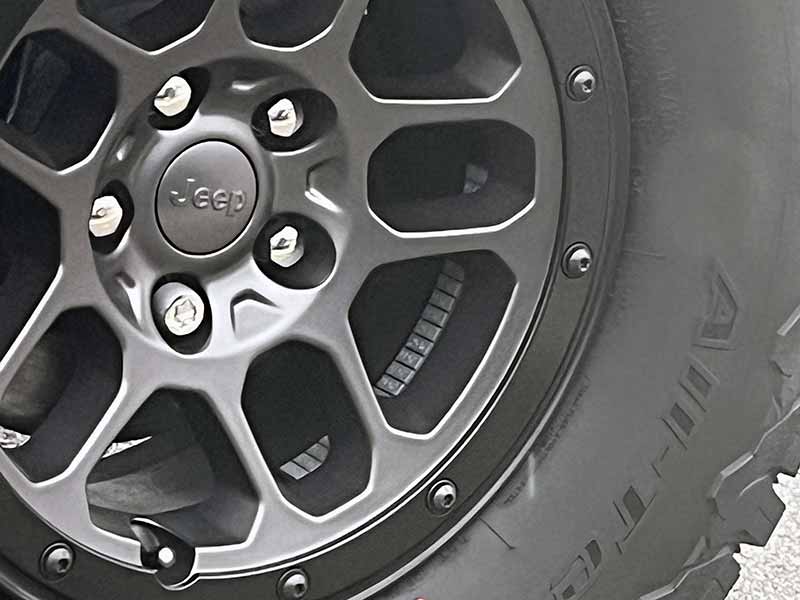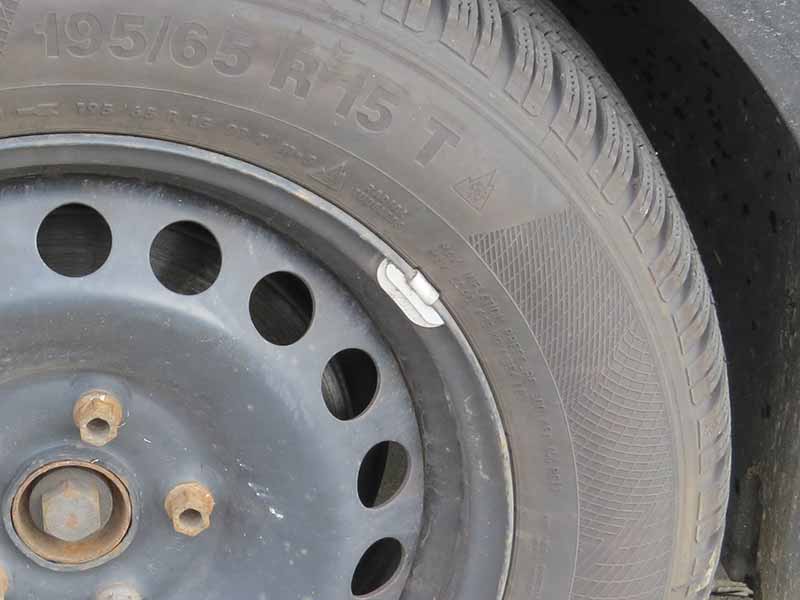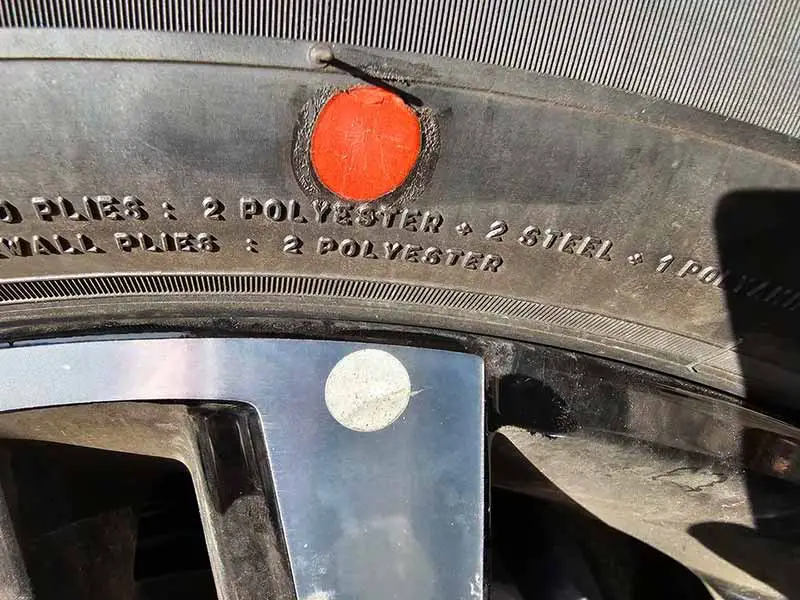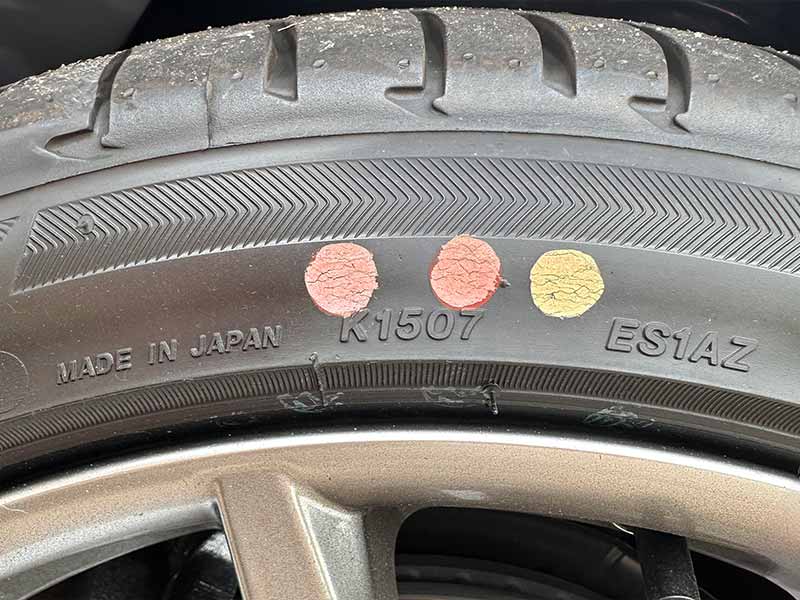Have you ever noticed those red, yellow, and occasionally white dots on new tires and wondered what they signify? These colorful marks are not random or merely decorative; they hold key information about your tire’s balance and structure.
Red and yellow dots on tires mark the high and light points for tire balancing purposes. By marking these points the tire tech can balance your tire extremely accurately. This helps reduce vibrations at higher speeds.
The red dot marks the highest point around the tire. The yellow dot marks the lightest point of the tire, and aligning this with the wheel’s heaviest point, often the valve stem, aids in achieving a balanced tire.
In this article, you’ll discover the significance of red, yellow, and white dots on tires, understand the importance of tire maintenance, and learn how they’re used give you a better driving experience.

Understanding Sidewall Dots
Ever noticed those colorful dots on new tires and wondered what they’re all about? They’re not a whimsical tire fashion statement or a secret code among tire manufacturers. These red, yellow, and sometimes white dots serve a crucial function in ensuring your tires perform at their best. So, let’s dive into the world of tire markings and discover what these dots really mean.
Red, Yellow, and White: A Story on Your Tire’s Sidewall
- Red Dots: These red marks indicate the tire’s high point of radial force variation. Aligning this red dot with the wheel’s low point (often the valve stem) helps minimize vibration for a smoother ride.
- Yellow Dots: Think of these as the tire’s ‘lightweight champion’ spot. Aligning this dot with the valve stem, which is the heaviest part of the wheel, helps in balancing the tire just right.
- White Dots: Not as common, but equally important. These are used for a more specialized balancing method called match mount balancing. They help align the wheel’s low spot with the tire’s high spot, reducing those pesky micro hops and enhancing your ride, especially at high speeds.
Why These Markings Matter
These dots are tire manufacturers’ way of saying, “We’ve got you covered!” They pinpoint the slight imperfections in a tire’s structure, which is inevitable given the complexities of tire manufacturing. It’s a bit like finding the best way to place a square peg in a round hole – the peg and hole aren’t perfect, but with the right positioning, they fit seamlessly.
Practical Tips: Using the Dots to Your Advantage
- Alignment for a Smooth Ride: Aligning these dots correctly when mounting your tires can mean the difference between a bumpy journey and cruising smoothly. It’s like finding the perfect sitting position in an office chair – it just feels right.
- Understanding the Balance: If you’re curious about the nitty-gritty of tire balancing and how these dots play a role, take a deep dive into What Is Tire Balancing?. It’s a treasure trove of information that demystifies the whole process.

The Meaning of Yellow Dots On Tires
When it comes to tire maintenance, the yellow dot plays a critical role. This simple mark represents the lightest part of the tire, a key aspect in achieving a balanced wheel-tire combination. Here’s what you need to know:
Yellow Dot Significance
- Location of Least Weight: The yellow dot indicates the section of the tire where it weighs the least.
- Balancing Act: Aligning the yellow dot with the valve stem, the heaviest part of the wheel, is essential for proper balance. This strategic placement reduces the need for additional balancing weights.
Balancing Made Easier
- Optimal Placement: Properly aligning the yellow dot helps achieve a more balanced wheel, which translates to a smoother ride and extended tire life.
- Reduced Weight Need: By aligning the lightest point of the tire with the wheel’s heaviest, the overall balance is naturally improved. This results in fewer additional weights required during the balancing process.
The Meaning of Red Dots On Tires
The red dot marks the tire’s high point, or the point of maximum radial force variation. In simpler terms, it’s the point where the tire’s radial runout is highest. Aligning this dot with the wheel’s low point (often the valve stem) helps in achieving a more balanced tire-wheel assembly.
Red Dot’s Role in Tire Balance
- Highest Radial Runout Indicator: The red dot marks the highest part of the tire.
- Alignment Objective: When mounting the tire, aligning the red dot with the low point on the wheel is key. This helps to minimize any imbalance and reduces the chances of vibration during drives.
Importance in Vehicle Handling
- Minimizing Vibration: Proper alignment of the red dot can significantly reduce vibration, enhancing the comfort and safety of your drive.
- Improving Tire Life: Correct alignment can also contribute to more even tire wear, extending the lifespan of your tires.

Red Dot vs. Yellow Dot: Prioritizing Tire Markings
When both red and yellow dots are present on a tire, understanding which to prioritize is essential for optimal tire performance. This section guides you on how to navigate this scenario.
Prioritization Rules
- Red Dot Takes Precedence: If a tire displays both red and yellow dots, the red dot should be aligned first. This is because addressing the tire’s high point is more crucial than balancing its lightest point.
- Alignment Focus: Aligning the red dot (high point of radial force variation) with the wheel’s low point (often marked by the valve stem).
Impact on Tire Performance
- Enhanced Stability: Prioritizing the red dot can lead to better vehicle stability and handling, especially at higher speeds.
- Improved Tire Life: Correct alignment using these dots can reduce uneven wear, thereby extending the tire’s lifespan.

The Meaning of White Dots: Specialized Balancing Technique
White dots on tires, though less common, hold significant importance in the balancing process. This section explains their role and the concept of match mount balancing.
White Dot and Match Mount Balancing
- Indicates High Spot of Tire: The white dot is used to align the tire’s high spot with the wheel’s low spot.
- Match Mount Balancing: This technique involves matching the tire’s high point with the wheel’s low point, improving overall roundness and reducing micro hops.
Advantages of Match Mount Balancing
- Reduced Vibration at High Speeds: This method is particularly effective in eliminating vibrations, especially at higher speeds.
- Optimizes Ride Quality: Match mounting can enhance the smoothness of your ride, making it more comfortable and stable.

Importance Of Properly Balanced Tires
Properly balanced tires are crucial for a safe and enjoyable driving experience. This section explains why tire balance is so important and how it impacts your vehicle.
Why Balance Matters
- Enhanced Driving Comfort: Balanced tires prevent vibrations, leading to a smoother ride.
- Improved Fuel Economy: Properly balanced tires can improve your vehicle’s fuel efficiency.
- Effective Braking: Balanced tires ensure more consistent contact with the road, enhancing braking effectiveness.
- Even Tire Wear: Balanced tires wear more evenly, extending their lifespan.
Consequences of Imbalance
- Vibrations and Noise: Imbalanced tires can cause noticeable vibrations and noise, especially at higher speeds.
- Premature Wear: Imbalance can lead to uneven tire wear, requiring more frequent replacements.
- Strain on Vehicle Components: Unbalanced tires put extra stress on suspension and steering components, potentially leading to premature wear.

Causes of Tire Imbalance
Understanding the common causes of tire imbalance is key to maintaining optimal vehicle performance. This section explores various factors that can lead to imbalanced tires.
Common Causes Leading to Imbalance
- Tire Wear: As tires wear down, their weight distribution changes, causing imbalance.
- Inflation Issues: Over or under-inflated tires can lead to uneven weight distribution.
- Improper Alignment: Misalignment can cause uneven tire wear, affecting balance.
- Lost Wheel Weights: If wheel weights used for balancing fall off, it can lead to imbalance.
- Wheel or Tire Damage: Damage from impacts like hitting potholes can disrupt tire balance.
- Valve Stem Issues: A leaky or damaged valve stem can affect tire pressure and balance.

Maintenance and Troubleshooting
Regular maintenance and timely troubleshooting are essential for keeping your tires in top condition. This section provides practical advice on maintaining tire balance and addressing common issues.
Regular Tire Maintenance
- Tire Rotation: Regularly rotating your tires ensures even wear and maintains balance.
- Balancing Check: Have your tires balanced during routine maintenance, such as oil changes.
- Inspection for Damage: Regularly inspect tires for damage or wear that can affect balance.
Troubleshooting Vibrations and Imbalances
- Vibration Issues: If you notice vibrations while driving, it could indicate a balance issue, possibly due to lost wheel weights or wheel damage.
- Professional Assessment: In case of persistent issues, visit a professional for a thorough checkup.
Resources
Below are some links you may find helpful when learning about tires:
Final Thoughts
This article has demystified the colorful dots on tires, explaining their role in tire balancing and overall vehicle performance.
Tire manufacturers and shops go to great lengths to ensure your tires roll smoothly down the road. Not just for comfort but for improved performance and long tread life.
Remember, regular maintenance, including proper balancing, is key to vehicle safety and efficiency.
Good luck and happy motoring.




